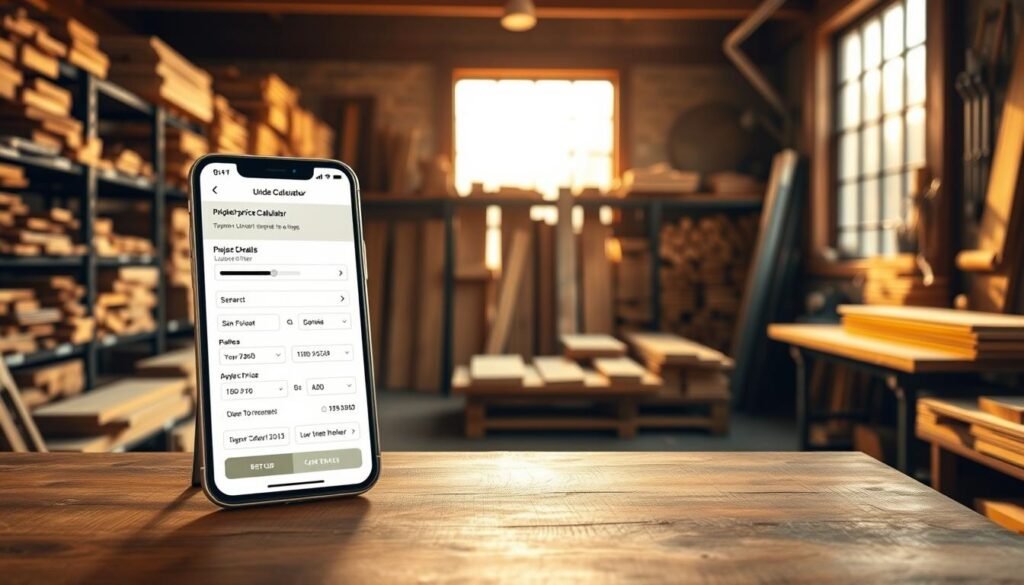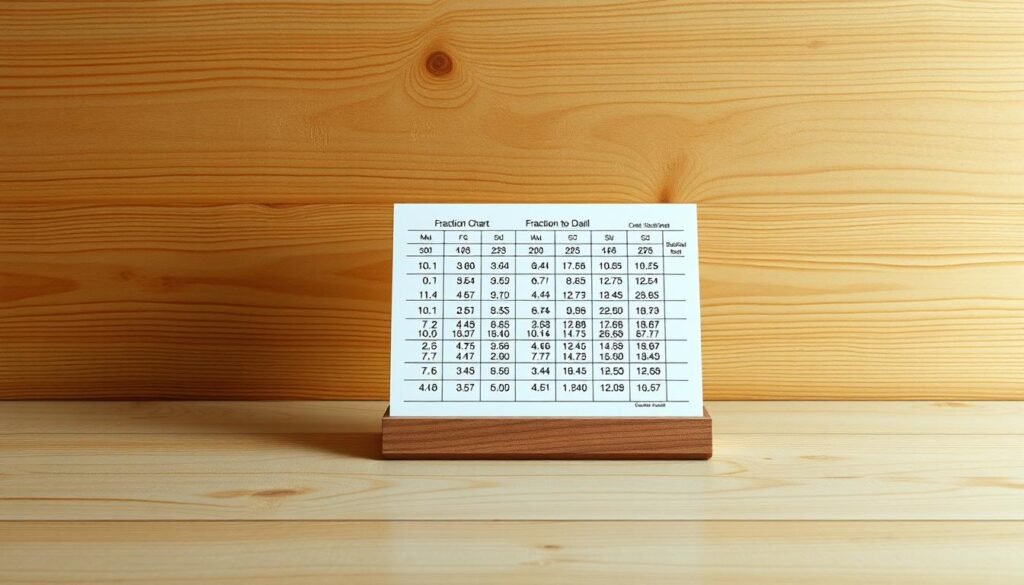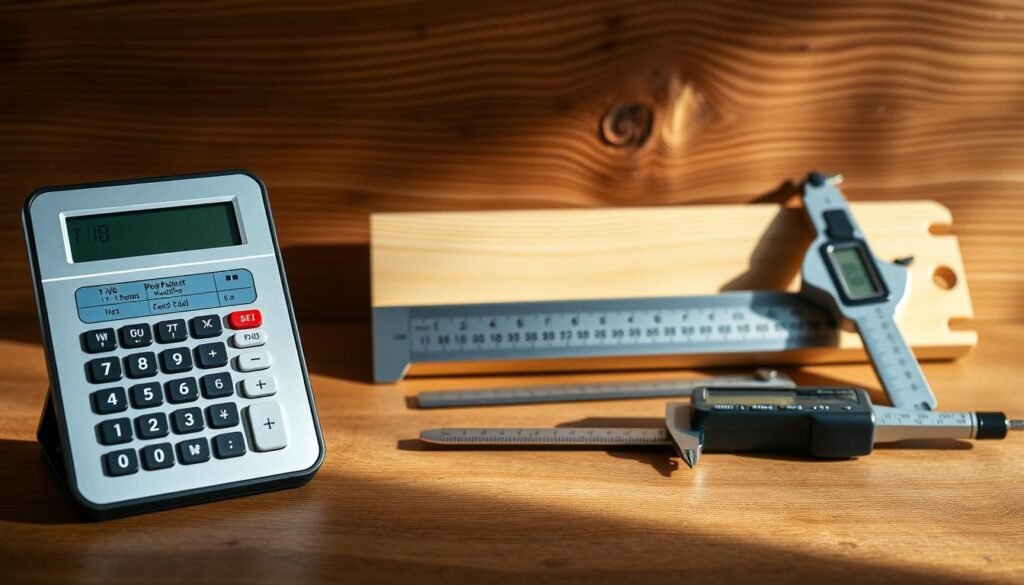Building safe outdoor steps is key for any deck project. A deck stair calculator is vital. It helps homeowners and builders make stairs that follow local codes. This ensures a safe outdoor area.
A stair calculator tool makes designing outdoor steps easier. It considers step height, tread depth, and staircase size. This tool helps create a detailed plan for outdoor steps. It reduces accident risks and meets legal standards.
Why Proper Deck Stair Calculations Matter
Getting deck stairs right is key for safety and following local rules. Badly made stairs can cause accidents. So, it’s important to follow safety guidelines.
A deck stair calculator makes things easier. It helps ensure your stairs are safe and meet building codes. This is very important when you’re doing a deck renovation.

A stair building calculator helps avoid mistakes. This makes your outdoor stairs safe and long-lasting. Using the right tools and doing the math right is worth it.
Understanding Basic Stair Terminology
Before starting on stair construction, it’s key to know the basic terms. Knowing the parts of a stair is vital for a safe and useful staircase. The main parts are the tread, riser, stringer, and handrail.
The tread is the flat part you step on. The riser is the vertical part between the treads. The stringer supports the treads and risers. Handrails add safety, helping the elderly and young.
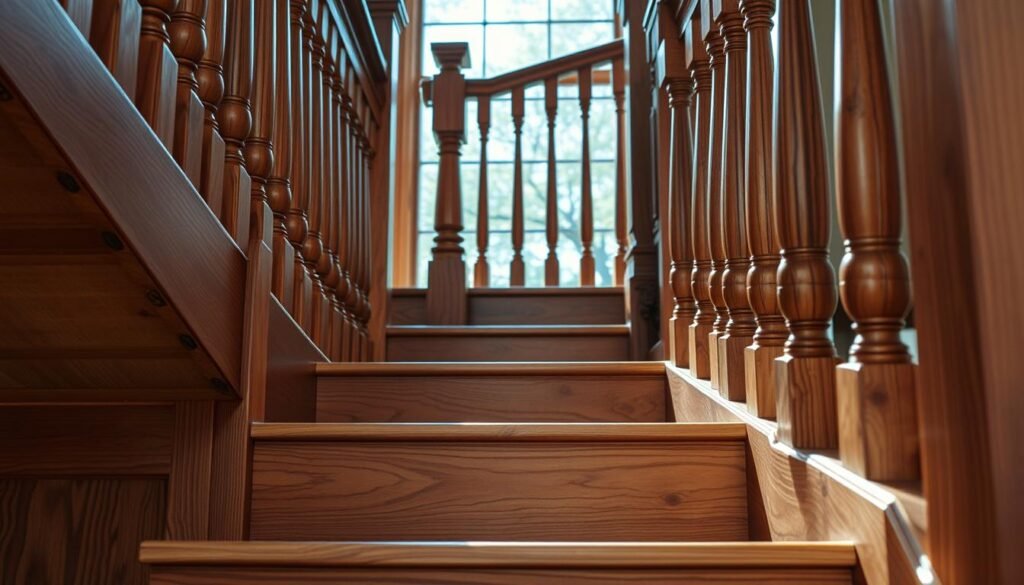
The stair angle, or pitch, is important for comfort and safety. A good stair angle depends on who will use it. For example, a gentler slope is better for the elderly or young kids. A steeper angle might be okay in some industrial places.
A stair angle of 30 to 37 degrees is usually good for home stairs. But, this can change based on local rules and who will use the stairs. Knowing these details helps in making a safe and useful stairs plan.
Deck Stair Calculator: Build Safer Outdoor Steps Fast
A deck stair calculator makes building outdoor stairs easy and safe. It helps homeowners and builders create stairs that are both strong and look good.
This tool considers things like stairs sizes and types. It lets users figure out how many steps they need and what each step should be. Just enter the stairs’ total rise and run.

The 7-11 rule is key in outdoor stair design. It says the riser height (about 7 inches) plus the tread depth (around 11 inches) should add up to 18 inches. Following this rule makes stairs easy to climb and safe.
Using a deck stair calculator that follows the 7-11 rule helps avoid mistakes. It ensures the stairs have the right balance of riser height and tread depth. This makes stairs that work well and are safe.
In short, a deck stair calculator is a must-have for outdoor stairs. It makes calculations easy and ensures stairs are built to last and are safe.
Essential Measurements for Perfect Deck Stairs
Building a beautiful and safe wooden staircase starts with knowing the technical details. It’s important to get the stair dimensions right for a good design. You need to take several key measurements to make sure the stairs work well and look good.
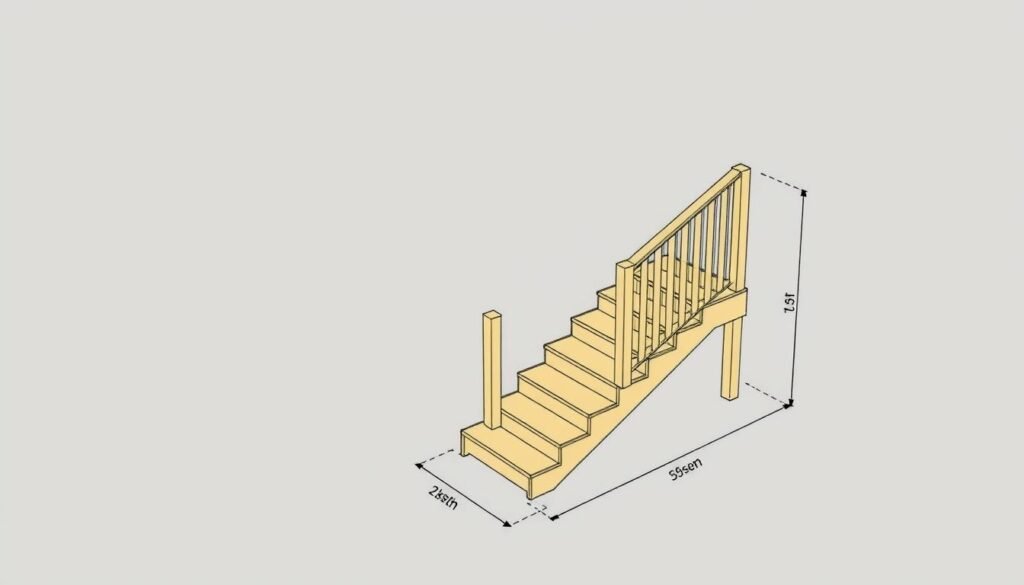
Measuring the total rise and total run is a big part of building stairs. The total rise is how high the stairs go from the deck to the ground. The total run is how wide the stairs are from the deck to where they end. These numbers help figure out how many steps you need and how big each step should be.
Accounting for Nosing Overhang
Nosing overhang is another important measurement. It’s the part of the tread that sticks out over the riser below. A good overhang is about 1 to 1.5 inches. It makes the stairs safer by giving you more room to step on. It also makes the stairs look better by defining the edges.
By thinking about these key measurements, you can make stairs that are both safe and look great. Getting these measurements right is what makes your stairs look professional.
Step-by-Step Guide to Using a Deck Stair Calculator
Using a deck stair calculator makes designing and building deck stairs easier. It helps figure out the number of steps, riser height, and tread depth. This ensures your stairs are safe and meet building codes.
To begin, you’ll need to enter some basic measurements into the calculator. This includes the total height from the deck to the ground and the stairs’ width. A stair stringer calculator can give you more detailed insights.
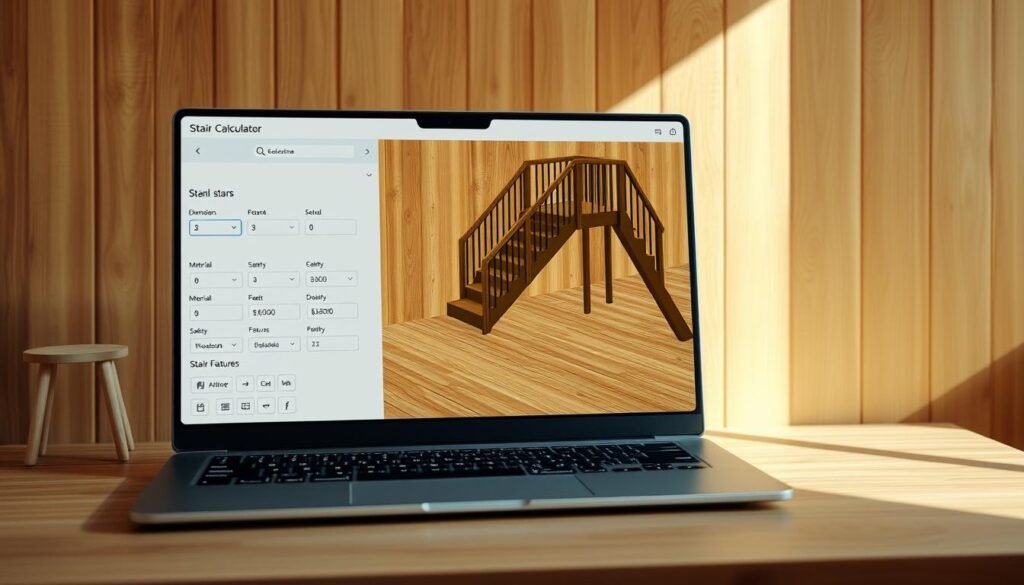
After getting your calculations, think about the practical parts of building your stairs. You’ll need to choose the right materials and make sure the stairs align with your deck.
Rounding Numbers for Practical Application
When using a deck stair calculator, you might see decimal numbers for measurements. It’s key to round these numbers to values that are easy to measure and use on-site.
For example, if the calculator shows a riser height of 7.25 inches, you might round it to 7.25 or 7.3 inches. This depends on your needs and the materials you’re using. Practical measurements make building easier and more efficient.
By following these steps and using a deck stair calculator, you can build safe and compliant deck stairs. These stairs will make your outdoor space more beautiful and functional.
Building Code Requirements for Outdoor Stairs
Building outdoor stairs must follow local building codes. This is not just a legal rule but also a safety must. Outdoor stairs need to handle different weather conditions and keep users safe.
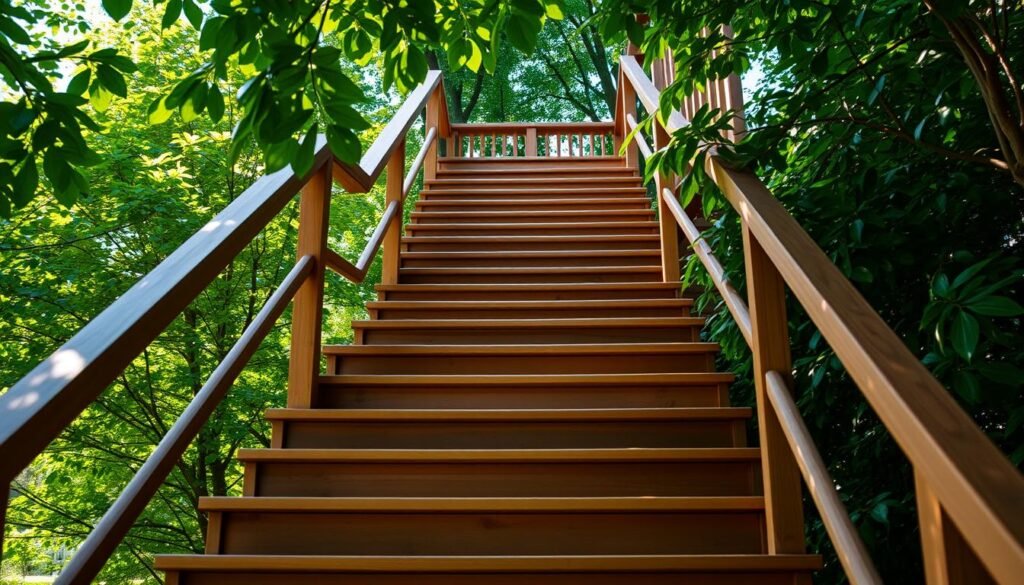
Building codes for outdoor stairs include the height and depth of steps, the materials used, and handrail installation. For example, the height of risers and the depth of treads are set to make stairs safe and comfortable.
Local vs. National Code Variations
Building codes can differ a lot between local and national levels. National codes offer a basic outline, but local rules might be stricter or have extra needs. For instance, places with lots of snow might need stairs designed to handle snow loads.
To follow the rules, it’s smart to talk to local building officials or a skilled contractor who knows local laws. For tips on using tools like a stair stringer calculator, check out this guide.
Materials Selection for Durable Deck Stairs
The materials for deck stairs are key to their durability and look. It’s important to pick materials that can handle different weather and lots of use.
Weather-resistant materials are a must for deck stairs. You can use pressure-treated lumber, woods like cedar and redwood, or composite materials. These are made from recycled plastics and wood fibers.
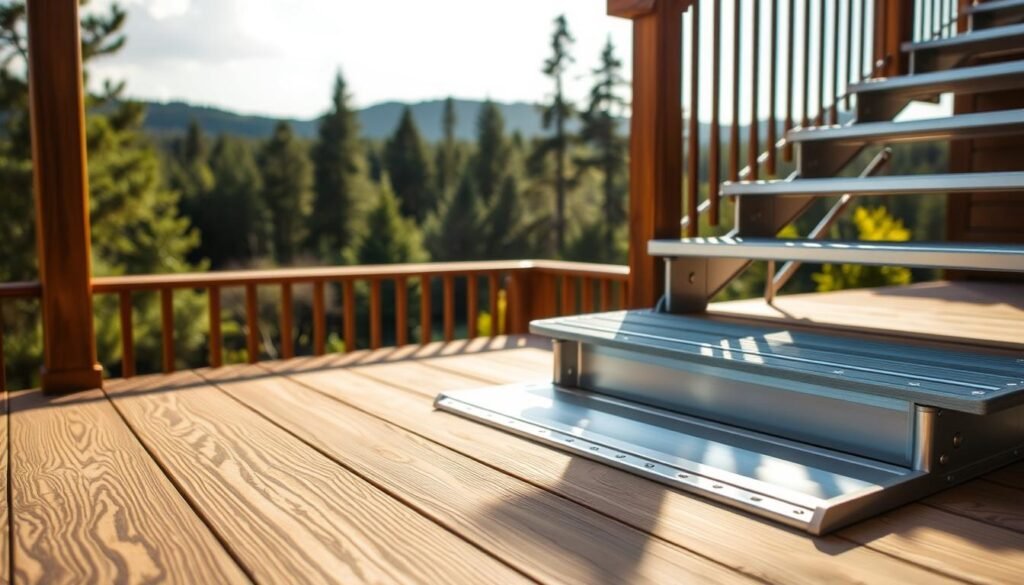
Using different materials can make deck stairs last longer and look better. For instance, composite treads and pressure-treated stringers are a good mix. They’re durable and easy to care for.
Another great choice is hardwood treads with metal or vinyl railings. This mix offers strength and style. The goal is to find materials that work well together in durability, upkeep, and looks.
Choosing the right materials and mixes helps homeowners make deck stairs that are safe and last. They also improve the look of the backyard deck.
Cutting and Installing Stair Stringers
To make sure your deck stairs are strong and meet building codes, learning to cut and install stair stringers is key. Stair stringers support the treads and risers of your stairs. A stair stringer calculator can help by giving you the right measurements.
When cutting stair stringers, being precise is important. You need to mark the stringer based on your calculations, considering the rise and run of each step. Using a template or a stair stringer layout tool helps ensure accuracy. For more details, a staircase construction details pdf can be very useful.
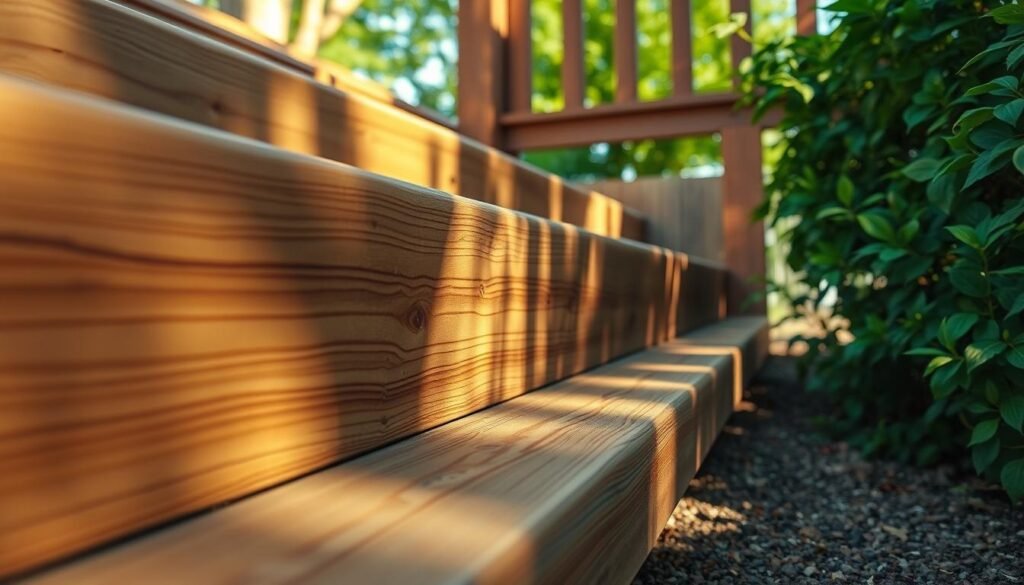
After cutting your stringers, it’s time to install them. Start by attaching the stringers to the deck frame. Make sure they are level and securely fastened. The number of stringers needed depends on the stairs’ width and local building codes.
Stringer Spacing and Support Requirements
It’s important to space and support stair stringers correctly for your deck stairs’ stability. Stringers should not be more than 16 inches apart. For wider stairs, more stringers may be needed to prevent sagging and ensure they can handle the load.
Creating stairs that are safe and durable requires attention to these details. By following the best practices for cutting and installing stair stringers, you can build deck stairs that will last for years.
Tread and Riser Installation Best Practices
Installing deck stairs correctly is key for safety and durability. The right installation makes your outdoor steps functional and safe.
Treads are the flat surfaces you step on, and risers are the vertical parts between them. It’s important to measure and install both correctly. Use materials like wood or composite for treads to withstand the outdoors. Make sure risers are well attached to prevent movement.
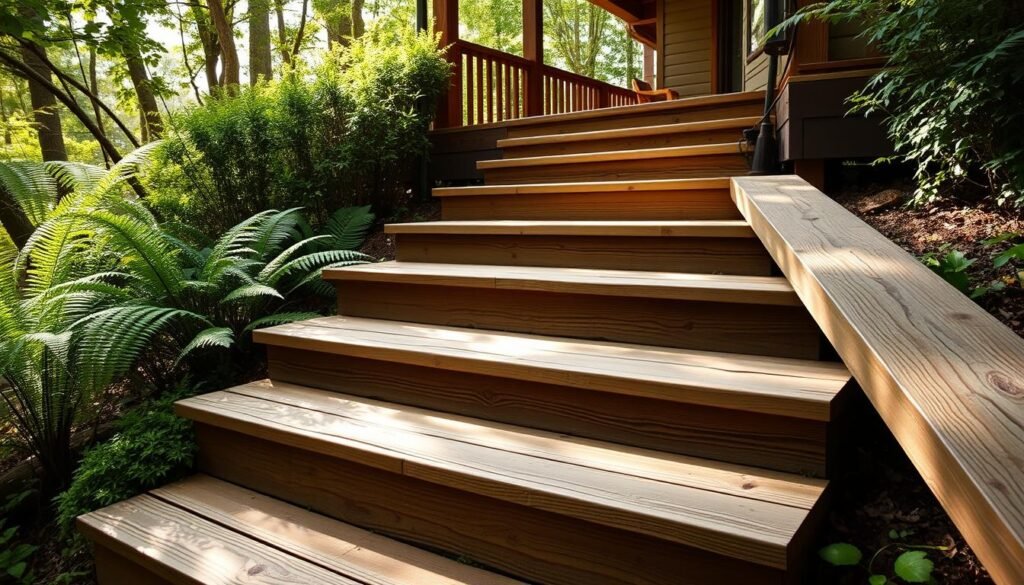
Outdoor steps need to be safe, as they face the elements. Adding anti-slip features is a good idea. For wood steps, anti-slip strips or textured finishes help prevent slipping. Also, keep treads wide and risers low for safer stairs.
By following these installation tips and adding anti-slip features, you can make your outdoor steps safe and welcoming. Whether you’re building new stairs or updating old ones, these guidelines will help you achieve a durable and safe result.
Adding Handrails and Balusters for Safety
Handrails and balusters are more than just decorations. They are key to keeping your deck stairs safe. A good handrail helps with balance and support. Balusters prevent falls by filling in gaps in the railing.
When picking out your handrail, think about both looks and function. The handrail should be between 34 and 38 inches high. This height makes it easy to reach and provides enough support.
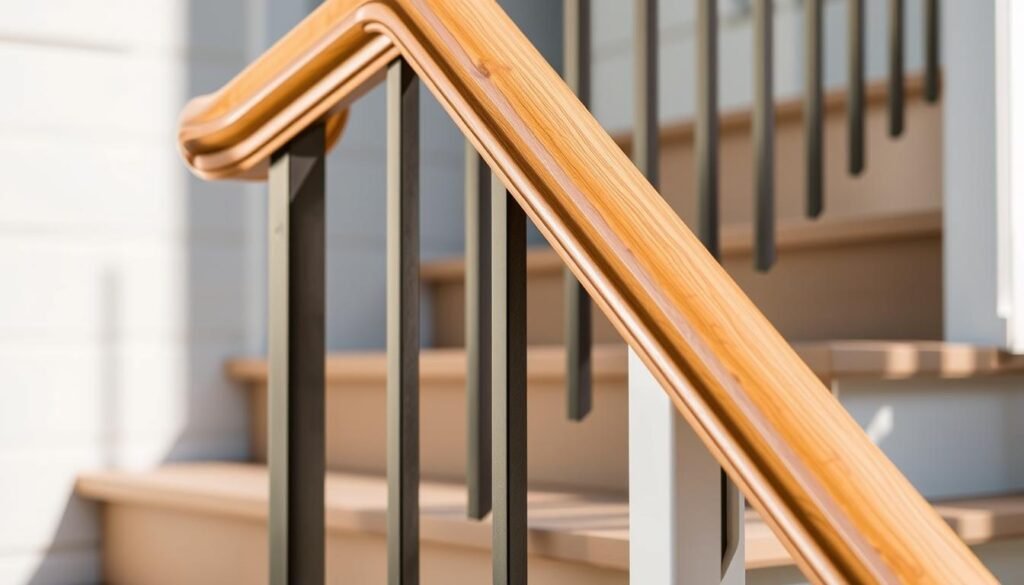
Even though safety is the main goal, you can be creative with your handrail and balusters. Pick materials and designs that match your deck’s style. Make sure balusters are no more than 4 inches apart to keep kids safe.
Adding decorative touches like ornamental metal or wooden balusters can make your staircase look great. Make sure your staircase plan includes these elements well. This way, your staircase will be both safe and stylish.
Common Mistakes to Avoid When Building Deck Stairs
Building deck stairs can be tricky. It’s important to know common mistakes to avoid. This way, your stairs will be safe and last long.
One big mistake is measuring wrong, leading to uneven steps. Not following local building codes is another error. It makes your stairs unsafe.
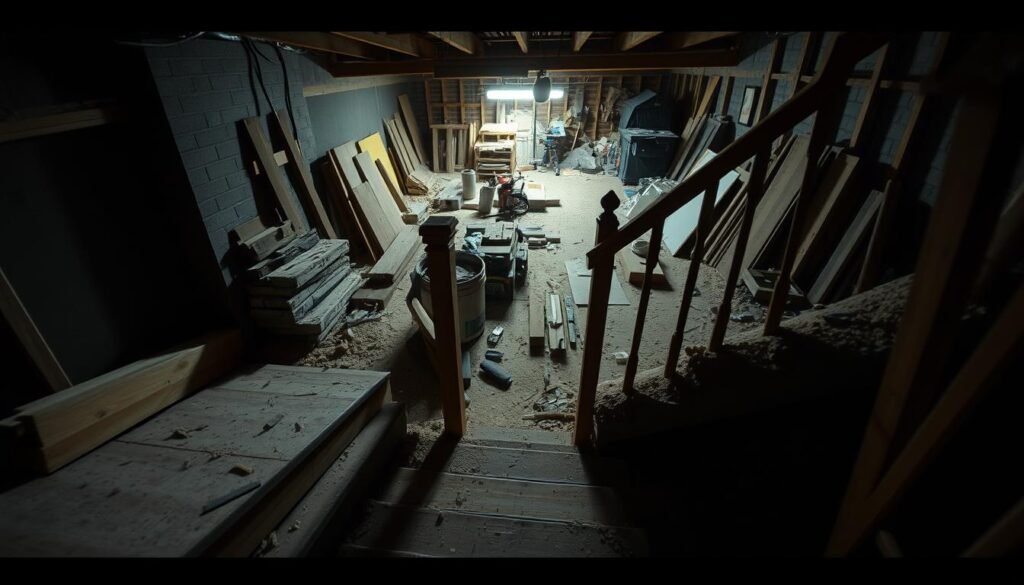
Choosing the right materials and design is key. They must handle different weather. Also, regular maintenance keeps your stairs in good shape.
How to Inspect Existing Stairs for Safety Issues
Regularly checking your stairs is a must. Look for signs of wear, like loose boards or damaged railings.
Check if the treads are even and not slippery. Make sure the stair stringers are well attached. This helps prevent accidents and keeps your stairs safe.
Conclusion
Following the guidelines in this article ensures your outdoor steps are both beautiful and safe. The deck stair calculator is key, helping you get accurate measurements and avoid mistakes.
Whether you’re doing it yourself or hiring a contractor, keeping stair safety in mind is vital. Knowing the basics, taking the right measurements, and following building codes helps you build steps that work well and are safe.
Starting your project? Remember, a deck stair calculator makes things easier. It lets you focus on the details of your outdoor area. With careful planning, your outdoor steps will be beautiful, safe, and last a long time.

